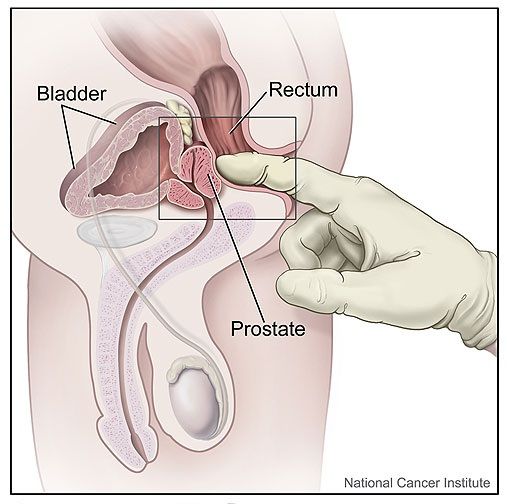The earlier cancer is detected, the greater the chance that it can be treated successfully.
Warning signs of prostate cancer can be detected early, before symptoms develop, with the prostate-specific antigen (PSA) blood test and a digital rectal exam (DRE).
What is the Prostate-Specific Antigen (PSA) test?
The PSA test was developed at Roswell Park in the 1970s and is now in use worldwide. It’s a way to detect prostate cancer in the early stages, when it can be treated most effectively. Since the test was first introduced, the cure rate for prostate cancer has increased from about 4% to 80%.
How does it work? PSA is a protein that’s made by the prostate gland. PSA levels in the blood increase when someone has prostate cancer, an infection, or a condition called benign prostatic hypertrophy (BPH) or benign prostatic enlargement (BPE), a condition that is not cancer. To perform the test, a small amount of blood is drawn from your arm and tested to determine the amount of PSA it contains.
Who should get a PSA test?
You should discuss whether prostate cancer early detection is right for you with your personal primary care physician. If you decide to pursue prostate cancer screening, Roswell Park recommends PSA testing as follows:
- People at high risk. This includes men assigned male at birth who are African-American, have a father or brother who had prostate cancer (especially if diagnosed younger than age 60) or have a known genetic mutation (such as BRCA1, BRCA2, ATM, HOXB13, MLH1, MSH2 or MSH6). Regular PSA testing should begin at age 40 or 10 years before the youngest prostate cancer case in your family (for example, begin at age 35 if your father or brother received a prostate cancer diagnosis at age 45).
- People at average risk. Men assigned male at birth who do not fall into any of the high risk groups above, should have baseline PSA testing at age 45 to compare with later years' results.
- Continue regular testing at 1- to 4-year intervals depending on your baseline or previous PSA level, your age and your risk factors. For example, if your first PSA test shows a level of 1.0 ng/mL or higher, you should undergo follow-up testing every one to two years. If your level is lower than 1.0 ng/mL, you should have follow-up testing every two to four years.
- Over age 75. You may discontinue PSA testing unless you are very healthy with a life expectancy of 10 years or more.
You should discuss the pros and cons of having a PSA test with your doctor. If you do receive a PSA test, your doctor will need to put the results in perspective with your age, how long you can be expected to live, your family medical history, your race and the results of any previous PSA tests.
Cruisin' for a Cure 2025
The car show that saves lives! Join us for a prostate cancer education and early detection clinic at Cruisin' for a Cure, Saturday, September 27, 2025.
What is a dangerous PSA level?
PSA levels are measured as a number of nanograms (units) in each milliliter of fluid tested. This is written as ng/mL.
- PSA level 2.5 ng/mL or lower: This is a normal PSA level for those under age 60, but in some cases, prostate cancer may still be present.
- PSA level between 2.5 and 4 ng/mL: This is a normal PSA level for most people.
- PSA level between 4 and 10 ng/mL: This indicates that prostate cancer might be present. At this level, there is about a 25% chance that you have prostate cancer.
- PSA level 10 ng/mL or above: There is a 50 percent chance that prostate cancer is present. The higher the PSA rises above 10 ng/mL, the greater the chance that you have prostate cancer.
Your doctor may also monitor your PSA velocity, or doubling time, which means recording your baseline PSA — the level at your very first PSA test — and seeing how fast the PSA level increases over time. Rapid increases in PSA readings can suggest cancer. If your PSA is slightly high, you and your doctor may decide to keep an eye on your levels on a regular basis to look for any change in the PSA velocity.
PSA levels can increase for reasons other than prostate cancer. These include aging, infection, difficulty urinating, the use of certain herbal supplements, or an enlarged prostate (not due to cancer). Some prostate glands naturally produce more PSA than others; for example, African-Americans tend to have higher PSA levels than those of other races. Your PSA level also may increase after ejaculating, exercising vigorously, bicycling or drinking alcohol, so doctors advise you not to do any of these things for at least three days prior to a PSA exam.
The role of PSA in choosing the best treatment
If you have received a diagnosis of prostate cancer, your PSA levels can be used along with the results of other tests and physical exams and your tumor’s Gleason score to help determine which tests are needed for further evaluation and to decide on the best treatment plan. After treatment has begun, your PSA and other tests will be used to determine how well the treatment is working: The more successful the therapy, the lower the PSA.
Digital Rectal Exam (DRE)
The digital rectal exam enables your doctor to feel anything abnormal in the posterior (rear) area of your prostate, where most prostate cancers develop. Wearing a lubricated glove, the doctor will gently insert a finger into your rectum and check for any lumps or other irregularities that might be signs of prostate cancer.
Experts in urology care
If you are experiencing symptoms consistent with urinary issues, we urge you to complete our urologic cancer risk assessment form.



